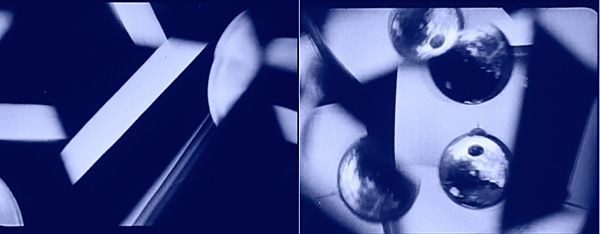|
This theory work will be published as a book-length monograph Beyond Spatial Montage: Windowing, or, the Cinematic Displacement of Time, Motion, and Space by Focal Press.
Part 4 of a 6 Part series proposing an expanded theorization of spatial montage, excerpted from a current book project.
Motion�Space Displacement (Mirroring)
The most easily identified variety of Motion�Space displacement, a tessellated array of (typically) triangular images, is immediately recognizable as being kaleidoscopic. However, any mirroring, even a simple vertical �reflection� on screen creating a symmetrical pattern would qualify as a Motion�Space displacement. These simple forms are the most common: mirroring is the earliest form of windowing to be developed since the visual structure happens continuously in �real time� since it does not require the motion picture as technological support�as a result, the first examples of this displacement are pre-cinematic. They appear in the eighteenth and nineteenth centuries as developments in kineto-optical devices (both photography and the motion picture are also examples of these scientific concerns). While a simple �split screen� (two images) would not be an example of this technique, if it were instead a mirroring of the frame (so long as it was not a superimposition of the frame flipped horizontally or vertically) it would qualify as the simplest variety of Motion�Space displacement. Complex versions with multiple reflections, often resembling a kaleidoscope, are more readily identified versions of this visual displacement.
Time is not displaced within this visual structure since the duration and timing of the visible material remains synchronized and simultaneous throughout the frame (a factor that distinguishes it from the displacements of video feedback that often reveal a delay, however slight). The Scottish physicist Sir David Brewster created a device for producing this type of imagery with The Kaleidoscope, patented in 1817 [Figure 18a�c]. His term for the device and the type of imagery it produced is derived from joining several words in Greek: �kalos� meaning �beautiful� + �eidos� meaning �form� + �scope� meaning �to see.�
The organization of optical elements that produce the displacements�reflectors or prisms creating reflections�guarantee the simultaneity of all motions and the continuity of reflections throughout the entire field of view in a continuous field of simultaneous action, each sample mirroring each other instantly. This immediacy is the determinant of Motion�Space displacement. Brewster�s initial design is not only typical of later designs, it fully encompasses the systems developed for motion picture cameras. The continuous nature of the time shown makes the graphic and spatial displacements appear to be linked�all displayed actions spread simultaneously across the various framed elements. The most common constructions use three mirrors or prisms, set either to form acute angles (60-30/45-60) or equilateral triangles (60-60-60). Different quantities and angles of mirror combination create imagery based in a network of reflections�depending on the size, number, and angles of reflection, the variety of imagery generated by these constructions will vary greatly. Consequently, each type of apparatus produces different kinds of imagery.

Motion�Space Displacement from Ballet M�canique (1924) showing kaleidoscopic reflections.
Motion�Space displacement tends to be dominated by decorative kaleidoscopic imagery, and consequently its applications in motion pictures�the use of these displacements as flourishes is a translation of the abstracting quality they present. That it is also unquestionably the earliest form of visual displacement makes its uncommon nature in this decorative mode entirely logical. The principles of Brewster�s optical device are well known, as is the kinesthetic character of the decorative abstractions it was designed to produce. The general neglect these forms have received, compared to other types of displacement, may be a reflection of the transformation of the kaleidoscope from entertainment to children�s toy.
Beyond Spatial Montage:
Part 1 Foundations
Part 2 Time�Space Displacement
Part 3 Time�Motion Displacement (Step Printing)
Part 4 Motion�Space Displacement (Mirroring)
Part 5 Time�Motion�Space Displacement
Part 6 Afterword
|